
Blockchain and 5G
Blockchain has a number of key capabilities that could be of benefit to a 5G network deployment.
Combining blockchain and 5G technologies will enable the benefits of both to be leveraged to great effect.
Authentication
One of the key characteristics of 5G is the delivery of services to a vast number of devices in a small area. This will prove challenging for network operators, especially when in 5G the devices are centrally authenticated via the core network. The large number of devices will be required to periodically register with the network and be authenticated, potentially placing high operating and capital expenditure on the network. This could be mitigated through the implementation of a blockchain based authentication system, implemented across all devices and network elements.
Subscription Data
One other aspect for consideration is the management of subscriber data, which again in 5G is centralized within the core network. With a potentially large number of procedures taking place, especially in connection dense areas, further pressure will be placed on the network. The subscription data could be distributed across the network utilizing blockchain technology.

Network Slicing
From the outset the 5G system has been designed to be an enabler platform for a range of services and applications. In order to accommodate the new wave of network stakeholders, innovative techniques have been introduced, such as the concept of network slicing.
To enable network slicing, operators will need to engage with the multiple stakeholders providing the services that will be delivered to the end devices. This engagement will include obtaining SLA (Service Level Agreement) based resource allocation requests from organizations, such as MVNOs (Mobile Virtual Network Operators) and then configuring the service requirements. In addition, services for vertical industries such as industrial, automotive, health, and augmented reality will be provided. This all needs to be done by securely exposing the network’s services and capabilities.
To assist with achieving this and to enable the key benefits of network slicing to be realised, blockchain technology could be used:
- Distributed ledger – a blockchain distributed ledger comprises of replicated, shared, and synchronized data that is validated through consensus. The ledger will be geographically spread across the permitted blockchain actors. It could record the verified identities of every network slicing stakeholder and blockchain participant allowing the use of digital signatures and transaction verifications.
- Smart contracts – blockchain smart contracts facilitate, verify and enforce the negotiation or performance of agreements. These could be used to negotiate and enforce SLAs between the various stakeholders. In addition, network resources could be allocated through the use of smart contracts.
- Oracles – smart contracts are unable to obtain external data, therefore a blockchain Oracle will be required to act as an intermediary. 5G could facilitate these, particularly in remote areas.
- Security – this could be enhanced through the use of blockchain. Network resources are critical and the distributed nature of blockchain prevents the occurrence of a single point of failure.

Want to learn more about Blockchain? Take a look at our Introduction to Blockchain course here.
